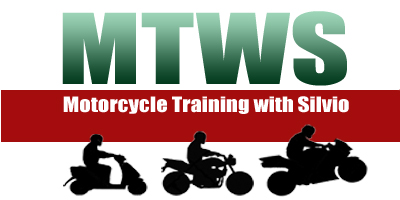Slow Speed ControlWhen it comes to slow speed control on a motorcycle, it’s all about the balance. The reason for this is simple physics; the slower you go, the greater role you play in keeping gravity from pulling your motorcycle onto its side. Slow speed control is an essential skill in urban environments, congested traffic zone and confined spaces. When turning on a motorcycle, the angle of lean and the speed are all related, as they all change simultaneously. When using slow control, you need to ensure any changes to the speed, turn, or lean of the bike is smooth and progressive to maintain balance and control. The principle is easy, however getting the feel for it takes practice. Through the required motorcycle lessons, I will assess your progress and develop your weak areas until you have mastered the technique of riding a motorcycle slowly. If you are struggling with slow-speed turning, try practice riding in a straight line and get familiar with changing the speed by only using the back brake. For more, please watch this video on Slow Speed Control PROTECTIVE GEARWhen riding a motorcycle, the first and most important thing to consider is safety. Are you well protected and fitted with the required gear? Rationally, we all know that, in the event of a crash, the best thing to be wearing is durable gear, if we want to minimize the potential for injury. However, this isn’t always on the minds of riders when jumping onto a motorcycle as some riders have an unrealistic view of their chances of going down. | Use Of The BrakesWhen riding a motorcycle, there are so many important fundamental aspects to learn. Some of these are accelerating, turning, slow speed manoeuvring, however one of the most important techniques is braking, and ultimately knowing how to use the brakes. In order to stop a motorcycle properly, you have to consider the surface of the roadway. Is the roadway you riding on made up of gravel? Black top? Tar? Because tar is made up of oil and grease, and tyres are made out of rubber and tar, heating these two materials together results in a greasy effect. When you slide tyres on the roadway, it burns a molten patch of rubber onto the ground which results in the motorcycle increasing speed for a slit second. The front brake on a motorcycle is proven to be the most effective of the two brakes, giving up to 80%-90% of the motorcycle’s stopping power in emergency stops. Because of this, the majority of the rider's weight must be applied and transferred forward onto the front wheel and suspension when the brakes are applied. Being confident in your use of the brakes and your stopping ability will help you maneuver and handle emergency situations more with less incident. There are several things you can do to brake safely and successfully. For more, please watch this video on the use of brakes Counter-steeringCounter-steering is arguably one of the most effective ways to steer a motorcycle. Once this technique is mastered, it will become your number one technique when steering a motorcycle. Through professional motorcycle training, this will become second nature to your riding ability. What is counter steering? The definition of counter steering is initiating a turn by pushing on the inside handlebar to lean a bike into a corner. Generally, counter steering works at speeds above walking pace due to the dynamics of the motorcycle. When counter steering, remember to keep your arms calm, still and parallel to the ground so you are pushing close to 90 degrees to the steering axis. This has a number of benefits which that will help your balance. If you are stiff and tense on your motorcycle, your body movements can also have objectionable steering inputs. Essentially, counter steering is used whenever you need to change direction and it should be your go-to technique when having to turn or change direction on a motorcycle. This applies to basic cornering manoeuvres, and even evasive manoeuvres such as swerving. In the case of a corner tightening up, it’s also important to be able to counter steer and prepare yourself for a tight angle. Failure to manoeuvre your motorcycle quickly will eventually result in an off-road collision or crash that can lead to a deadly outcome. For more, please watch this video on counter steering |
Videos & Resources
Motorcycle Training Resources

